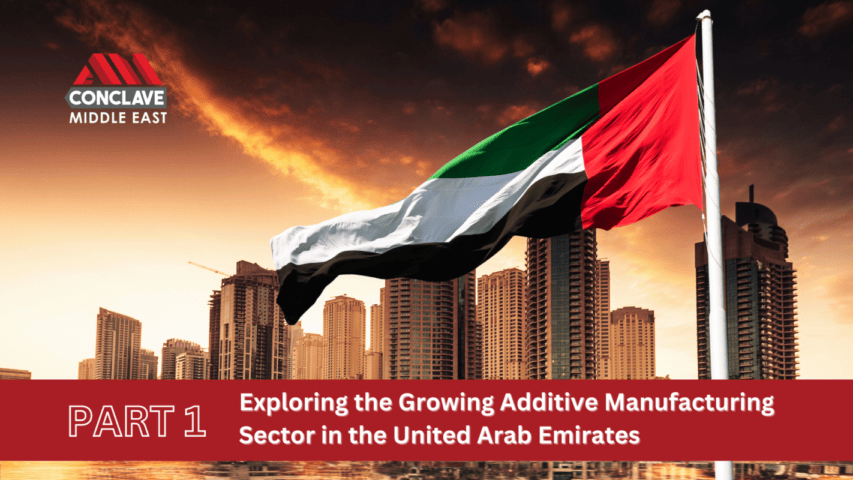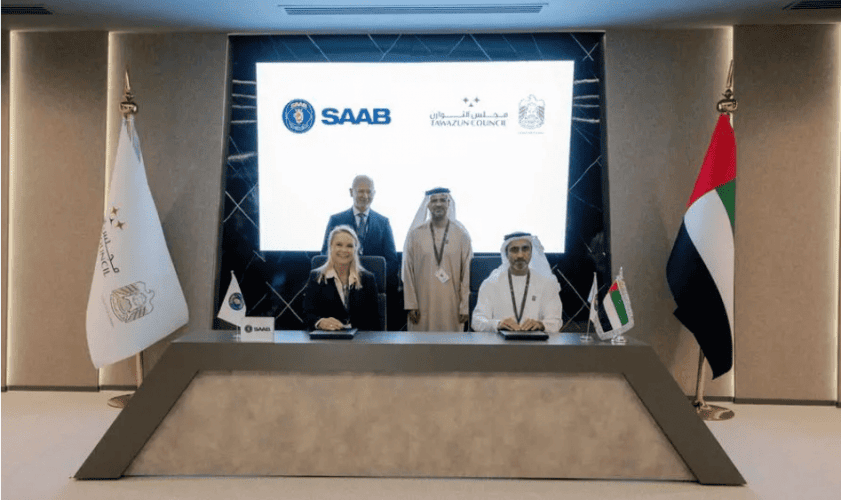Additive manufacturing (AM) is a rapidly growing technology that has the potential to revolutionize manufacturing. The UAE is one of the leading countries in the Middle East for Additive Manufacturing. The government has made AM a key focus of its innovation strategy, and there are a number of major companies and research institutions working in the field. According to the research report published by Bonafide Research, the United Arab Emirates 3D printing market size is estimated to be more than USD 1.15 Billion by 2028.
This article is the first part of article series by AM Chronicle powered by AM Conclave Middleast to explore Addtitive Manufacturing developments in the Middle East region pertaining to specific regions and applications. In this article we highlight the landscape of AM in United Arab Emirates covering various aspects including Government initiatives, opportunities, challenges and future of the 3D printing technology in the region.
Government Initiatives
The UAE government recognizes the immense potential of additive manufacturing and has implemented initiatives to promote its adoption and development. Some notable government initiatives include The Dubai 3D Printing Strategy and Dubai 3D Printing Strategic Alliance.
The Dubai 3D Printing Strategy
The Dubai 3D Printing Strategy is a government initiative launched in 2016 by His Highness Sheikh Mohammed bin Rashid Al Maktoum, Vice President and Prime Minister of the UAE and Ruler of Dubai. The strategy aims to make Dubai the world’s leading city in 3D printing by 2030.
The strategy has five pillars Infrastructure, Talent, Research and development, Incentives and Awareness. Under the five pillars the government will invest in the development of 3D printing infrastructure, including 3D printing labs, training facilities, and research centers. Support the development of a skilled workforce in 3D printing, through training programs and scholarships. It will also fund research and development in 3D printing, to develop new applications for the technology. Offer incentives to businesses and individuals to adopt 3D printing, such as tax breaks and grants and will raise awareness of 3D printing among the public, to encourage its adoption.

The Dubai 3D Printing Strategy has already had a significant impact on the city. The number of 3D printing companies in Dubai doubled from the previous year. The government has also opened several 3D printing labs and training facilities, and it has funded several research projects in 3D printing.
Collaboration between Austria and United Arab Emirates for development of additive manufacturing
Austria and the United Arab Emirates (UAE) have collaborated to establish additive manufacturing partnerships, aiming to leverage the potential of this advanced technology. These efforts reflect a joint commitment to innovation and technological advancement in various sectors.
The collaboration between Austria and the UAE in the field of additive manufacturing demonstrates a shared commitment to innovation and technological progress. By forging partnerships and exploring opportunities for research, development, and knowledge exchange, both countries aim to leverage the potential of additive manufacturing to drive industrial growth and economic prosperity. These efforts contribute to the broader global push for advancements in 3D printing technology and its widespread application across various sectors.
Dubai 3D Printing Strategic Alliance
The Dubai 3D Printing Strategic Alliance (DPSA) is a government-led initiative that was launched in 2020 by His Highness Sheikh Hamdan bin Mohammed bin Rashid Al Maktoum, Crown Prince of Dubai. The DPSA brings together government entities, academia, and 3D printing companies from around the world to accelerate the adoption and use of 3D printing technology.
The DPSA has four key objectives:
- To develop Dubai into a global hub for 3D printing technology.
- To promote the use of 3D printing in a wide range of industries, including healthcare, manufacturing, construction, and education.
- To support the development of a skilled workforce in 3D printing.
- To raise awareness of the benefits of 3D printing among the public.
The DPSA has already made significant progress in achieving its objectives. In 2021, the number of 3D printing companies in Dubai grew by 50%. The DPSA has also helped to launch several new 3D printing initiatives, including a 3D printing accelerator program and a 3D printing training academy.
Tawazun Council & Saab
Tawazun Council has unveiled the Emirati 3D Printing Centre of Excellence, marking a major milestone in the UAE’s pursuit of cutting-edge technology. The center aims to harness the potential of 3D printing for various sectors, with a particular focus on aerospace and defense. Additionally, the Tawazun Council has entered into a partnership with Saab to establish a sovereign 3D printing capability for the UAE Air Force and Air Defense. This collaboration will enable the UAE to develop advanced additive manufacturing capabilities domestically, reducing reliance on foreign suppliers and fostering technological independence.
Saab, a leading defense and security company, has successfully tested a 3D printed part on the Gripen aircraft. The trial was aimed at evaluating the viability of using 3D printing technology to facilitate battlefield damage repairs, thereby enhancing the operational readiness and efficiency of the aircraft.
Opportunities of Additive Manufacturing in the United Arab Emirates
Additive manufacturing presents an opportunity for the UAE to diversify its economy by fostering innovation and establishing itself as a hub for advanced manufacturing technologies. This can reduce the nation’s reliance on traditional industries and oil revenues. The technology also allows for the production of highly customized and personalized products. This can cater to the unique demands of consumers in the UAE, where luxury and bespoke products are highly valued. This service can also help the travel and tourism industry in the country.
The UAE heavily relies on imports for various goods. Additive manufacturing can help reduce dependence on foreign suppliers by enabling localized production and shortening supply chains. This enhances efficiency, reduces lead times, and mitigates supply chain risks. By utilizing additive manufacturing, the UAE can reduce material waste compared to traditional manufacturing processes. The ability to produce complex designs with minimal material usage promotes sustainability and aligns with the UAE’s vision for a greener future.
Challenges of Additive Manufacturing in the United Arab Emirates:
The initial investment required for acquiring additive manufacturing equipment and setting up facilities can be significant. This may pose a barrier to entry for small and medium-sized enterprises (SMEs) and startups in the UAE. Access to a wide range of materials suitable for additive manufacturing may be limited in the UAE. Importing materials can increase costs and affect the competitiveness of locally produced 3D-printed products.
Additive manufacturing technologies require specialized skills and knowledge. Developing a skilled workforce proficient in operating and optimizing 3D printers, designing for additive manufacturing, and post-processing techniques is crucial for industry growth, which is an potential challenge for development of additive manufacturing in UAE.
Some other challenges for AM in UAE are related to ensuring the quality and reliability of 3D-printed products is essential, particularly in industries with stringent regulatory requirements. Establishing standardized certification processes and quality control measures is a challenge that needs to be addressed. Additive manufacturing raises concerns related to intellectual property rights. Protecting designs and preventing unauthorized replication of 3D-printed products poses challenges that require effective legal frameworks and enforcement mechanisms.
Future of Additive Manufacturing in United Arab Emirates
The future of additive manufacturing (AM) in the United Arab Emirates (UAE) is bright. The UAE government has identified AM as a key technology for economic diversification and job creation, and has invested heavily in research and development in the field. As a result, the UAE is now home to a number of leading AM companies and research institutes, and is a major hub for AM activity in the Middle East.
There are a number of factors that are driving the growth of AM in the UAE. These include, the increasing demand for customized products and parts. AM can be used to produce complex parts with intricate geometries that would be difficult or impossible to manufacture using traditional methods. The need for lighter and stronger materials. AM can be used to produce parts from lightweight materials, such as composites, that are also strong and durable. The growing cost-effectiveness of AM. The cost of AM machines and materials has been declining in recent years, making AM more affordable for businesses.
The UAE is well-positioned to become a major center for AM in the Middle East. The country is working towards building a strong manufacturing sector, a skilled workforce, and a supportive government. As the AM technology continues to develop, the UAE is likely to play an increasingly important role in the global AM industry.
As the AM industry continues to grow, the UAE is likely to see even more applications for this technology. AM has the potential to revolutionize manufacturing in the UAE, and to create new jobs and opportunities for the country.
—-
AM Conclave Middle East is an initiative to bring the entire Additive Manufacturing and 3D Printing ecosystem in the Middle East on one platform including Government, Users, Software Providers, Hardware, Material Manufacturers, Research Institutes and Standards & Certification Bodies, with an aim to advance the adoption of AM in line with the various initiatives and strategies in the region to catalyze manufacturing.
The event will feature application and technology focussed conference mapping the latest developments and trends in the world of Additive Manufacturing. A high quality technical conference will also be supported by a technology showcase and networking zone for the industry stakeholders to showcase their solutions and exchange ideas.
For more information visit: https://amconclave.com/
Subscribe to AM Chronicle Newsletter to stay connected: https://bit.ly/3fBZ1mP
Follow us on LinkedIn: https://bit.ly/3IjhrFq
Visit for more interesting content on additive manufacturing: https://amchronicle.com



